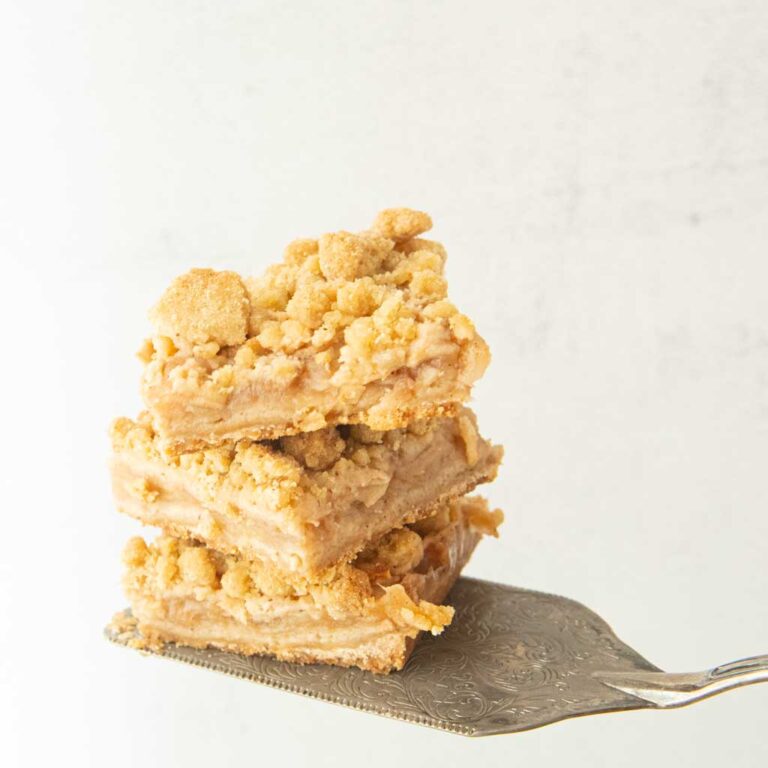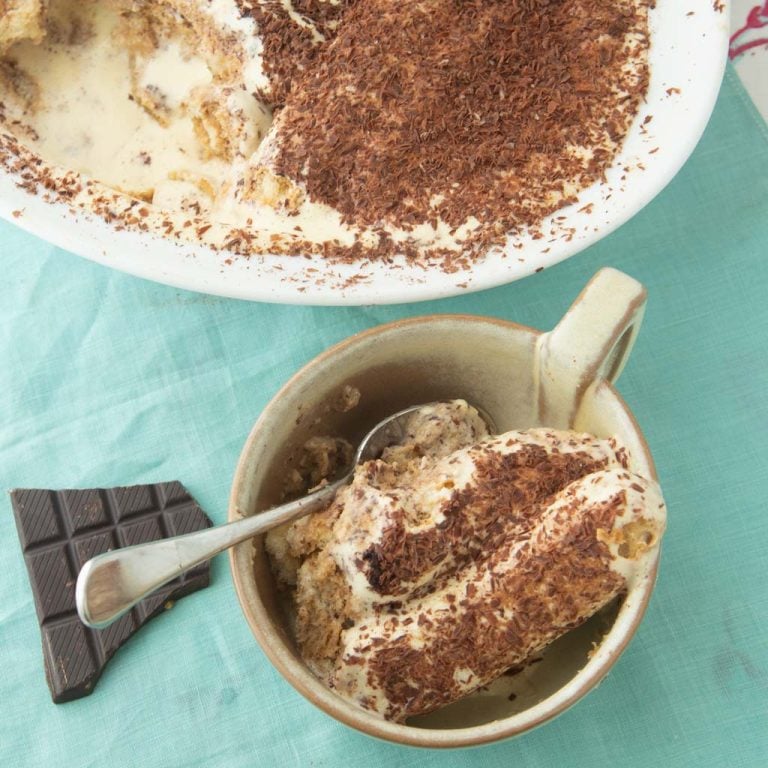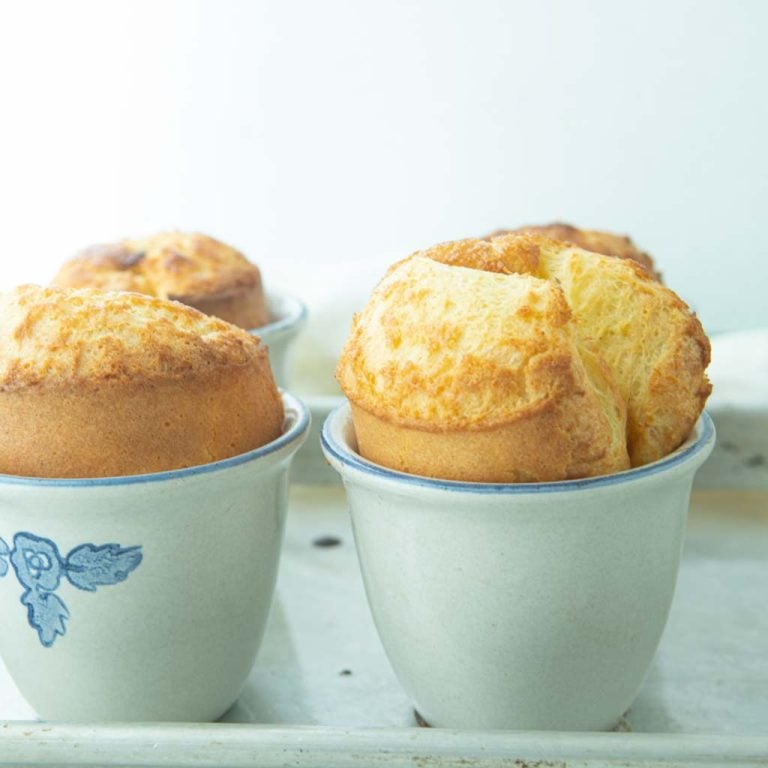Homemade Puff Pastry is easier than you think and so worth your time
bakingwithtradition.com is a participant in the Amazon Services LLC Associates Program, an affiliate advertising program designed to provide a way for websites to earn advertising revenues by advertising and linking to recommended products. Some of the links below are affiliate links. This means that, at zero cost to you, I will earn an affiliate commission if you click through the link and finalize a purchase.
We’ll making homemade puff pastry today which is a simple dough folded many times to enclose layers of butter that when baked puff up into impossibly flaky, shatteringly crispy, light, airy confections.
I think I came across puff pastry with an episode of Martha Stewart when I was a kid. She swore up and down that if you had puff pastry in your freezer, you could make an appetizer in 15 minutes. It took me many many years to get up the courage to figure this classic pastry out. I read books, watched videos, and everything seemed so overly complicated–so much so that my courage failed me and I would shelve it for another day.
Finally, becoming a baking teacher forced me to learn for the sake of my students. I gotta say when I finally screwed up my courage to try, making this was far less difficult than I had been led to believe. Shoot, it’s harder to write about how to make it than it is to actually make it. And yes, Martha was right–once you have this incredible pastry in your freezer, you CAN make palmiers, schaumrolle, cheese straws, turnovers, and any other number of jaw-droppingly good pastries in the blink of an eye.
And no, you will not see a recipe for rough puff pastry here because you’ll see it’s just not as hard as you’ve been led to believe. I say that as someone who was terrified about this dough for YEARS. Don’t be like me. Let me show you how easy it is to make classic puff pastry. And if this still looks like too much, try my easy cream cheese pastry–it’s almost as good and very quick to make.
You got this, I promise.
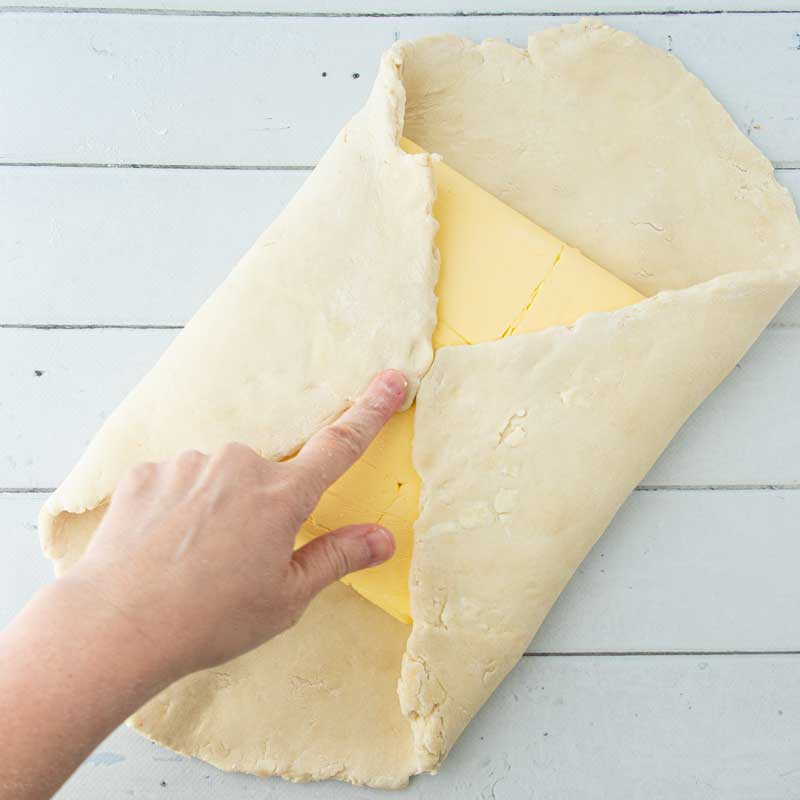
Puff Pastry Recipe

What even is puff pastry?
Puff pastry is a laminated dough, called pâte feuilletée in French, Blätterteig in German, and pasta sfoglia in Italian and many other names in other languages.
Laminated doughs are made when you take a plain dough made of flour and water (or milk) and use it to enclose a block of butter or other fat like lard. By folding the dough over itself and rolling and folding and turning the dough, the butter block gets thinned out and redistributed into a growing number of layers of butter between dough.
When you bake this pastry, the butter melts, creating steam between the layers of dough, and the dough “puffs” up to create the extremely thin, crispy layers that we love so much.
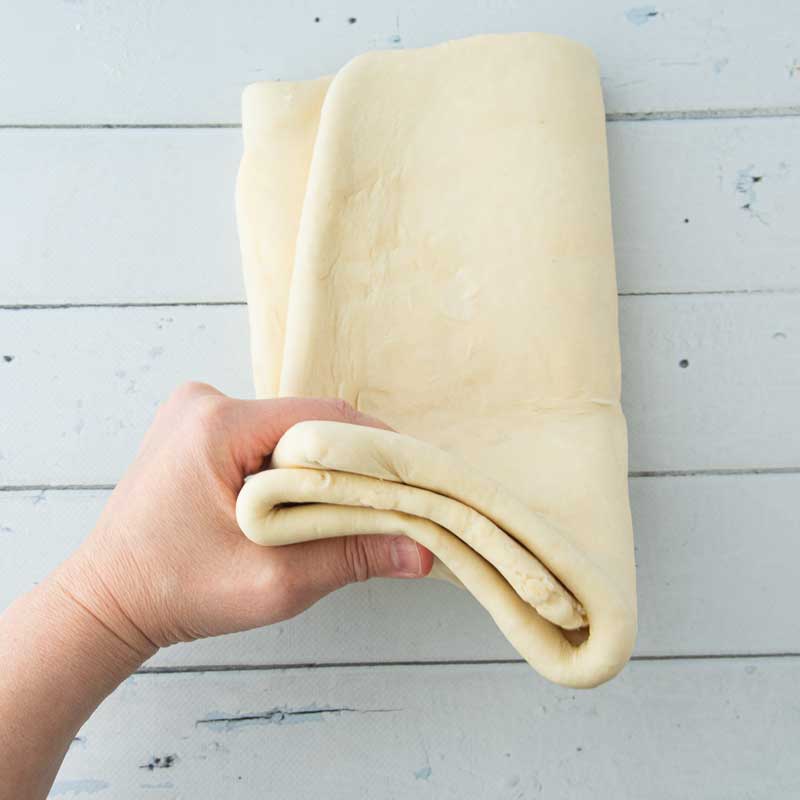
Why people buy frozen puff pastry
Most people buy frozen puff pastry out of convenience. There are so many things you can make in so little time with puff pastry, that it makes sense why people would want a shortcut.
And yet…frozen puff pastry is rarely made with all or any butter, and often with ingredients you may not want to be eating. I see you high fructose corn syrup!
Why homemade puff pastry is worth your time
- Cheaper: People, frozen puff pastry is really really pricey for the amount you get in a box. You can literally use the fanciest butter out there and still be money ahead.
- Better ingredients for better taste: Homemade puff pastry is just so much tastier. You cannot beat the flavor of all butter and you can use better flour, giving you a much higher quality than something you can buy.
- It takes less time than you think: Puff pastry takes a long time to get a batch from start to finish, but very little of that time is active time. For a batch, it takes no more than 15 minutes of active time spread out over several hours. If you can make bread, you can puff pastry.
- Relaxing and Rewarding: Who would think that beating a block of butter in between a sheet of dough could be relaxing? Yet it is! After your first turn, you’ll start to see the layers build up and your dough get easier and easier to handle.
Bonus note: If your dog is like mine, puff pastry will surely cement your best friend relationship. My Mom is always sneaking my Sundae bits of baked puff pastry. As a result, when I’m making a batch, Sundae follows me around the kitchen with the intensity that’s somewhere between a poor miserable starving waif and a hypnotist. She’s dead serious about her goal!

Ingredients for puff pastry
- Flour
- Butter
- Salt
- Milk or water (I use milk here which makes for a puff pastry that’s closer to Danish pastry dough which is essentially puff pastry with yeast, but water is also good).
A note on butter
While it’s true that you can make laminated doughs with other fats, butter will give you the best flavor. Additionally, European style butters are better still because they have a lower water content and thus higher fat. That fat gives you more flavor.
The one piece of equipment you need for puff pastry
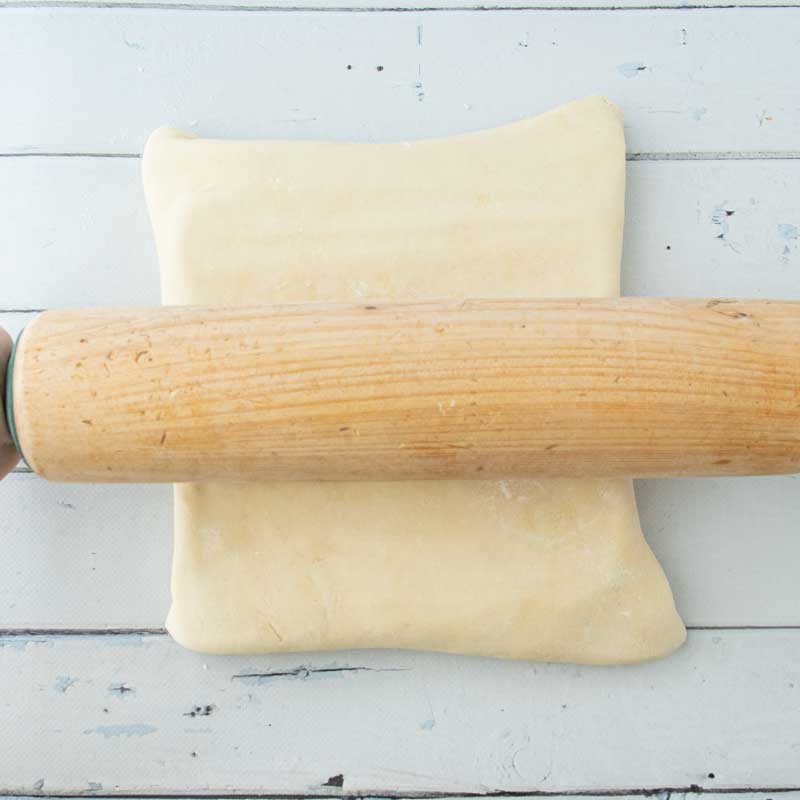
A Solid rolling pin: Pick a rolling pin that’s heavy for its size. It can have rolling handles or not. Don’t let anyone bully you into using a French rolling pin; the best rolling pin is what’s comfortable for you to use and provides adequate leverage during rolling.
Puff pastry vocabulary
- Butter block: literally a block of butter. You’ll form the butter block by smoothing room temperature butter into a form and then chilling it. The butter block gets encased in the dough to start forming the layers.
- Turn: A turn refers to one time of rolling out the puff pastry and folding it in thirds before turning it 90 degrees and rolling it out again across the folds you just made. Good puff pastry has 6-8 turns. Beyond that the layers become so thin that they have less room to puff, so it becomes less worth your time to keep adding layers.
Tips for the best puff pastry
- Use the gram scale: This is one time I will not give standard American measurements in the recipe as the proportion of butter and liquid to the flour is important. Pull out the gram scale if I haven’t already convinced you that it’s the smartest tool to use as a baker yet!
- Keep things square: I’ve stopped measuring my sheets of puff pastry, but it is helpful to make sure that you’re working square. Ragged edges will give you uneven lamination and be annoying to work with. There’s a lot of people who will cut off edges with a pizza wheel to make sure they’re working square. It’s not a bad idea.
- Use better butter: Another plug for European style butters. For some reason, these higher fat butters are also more flexible, making it easier to roll into layers of butter that don’t break when you roll them.
- Cold yes, hard, no: It’s important for the butter to be cold, but if it’s too cold, you’ll have to bash it to flatten it between the layers of dough. This is no fun and it could lead to you squashing the butter so that it breaks inside, leaving you with uneven lamination. Simply set your butter out for about 15 minutes before you enclose the butter block in dough. In that time the butter will warm up enough to be workable.
- Wrap, wrap, wrap: Always rewrap your dough in plastic between turns. It will keep the dough from drying out.
- Chill, chill, chill: Chilling the dough between turns will firm the butter back up and allow the gluten to relax. If you try to speed run this process, you’ll end up with tough dough that won’t puff correctly.
How to make puff pastry and not let it become THAT kitchen project that takes over your whole life
Making puff pastry is quite literally something that you do piece by piece in between other things. Here’s how I manage it:
- Morning, day 1: Take out the butter and let it come to room temp.
- Evening, day 1: Make the butter block, wrap it. Make the dough and wrap it. Place it on a sheet tray and place it in the fridge. My fridge has a pull-out drawer that makes this easy for chilling. If you don’t have this, just set your tray somewhere in your fridge for easy access.
- Day 2: Enclose the butter, do the first turn, chill.
- 30 minutes-1 hour later: next two turns.
- 30 minutes-1 hour later: next two turns.
- Ready to use or wrap for the freezer: Usually I’ll use some of the pastry straight away and then wrap up the rest of it, first in plastic, then in a plastic bag for the freezer. When I need to use puff pastry, I’ll let it thaw in the fridge overnight.
Truly, after the first time you make this, you’ll sense the process, and the turns will become second nature to you, taking no more than a couple minutes at a go.
Print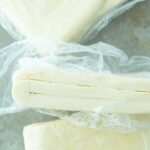
Homemade Puff Pastry
- Total Time: 4 hours 30 minutes (mostly chilling time)
- Yield: 3 pounds 1x
Description
Homemade puff pastry is lightyears better than the frozen stuff at the store, which often isn’t made with butter or worse has creepy ingredients nobody needs. For your effort, you’ll be rewarded with pastry that’s easy to work up into shatteringly crispy palmiers, pastries, and so much more. If air could be both crispy and buttery, that’s what real puff pastry tastes like!
Ingredients
- 1 pound of butter, at room temperature
- 500 grams of flour (1.1 pounds)
- 1 teaspoon salt
- 250–275 mL milk
Instructions
Make the butter block: Measure out the flour into a bowl. Scoop out 1/3 cup of this flour into a mixer bowl. Beat the flour with 3 butter sticks until you have a smooth paste. Line an 8 x 8 pan with plastic wrap. Spread the butter into a square over the plastic wrap and then wrap it in the plastic. Chill the butter block until firm. 
Make the dough: Mix the remaining flour with the last stick of butter and salt. Break up the butter so that it’s coated in the flour and makes crumbs. Pour in the milk and mix just until the dough comes together. Depending on the weather and the humidity, you may or may not need the last couple tablespoons of milk. The dough should come together easily but not be dry or sticky. Pat the dough into a square just slightly larger than the butter block. Wrap it and chill for several hours.
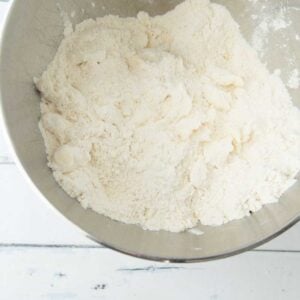
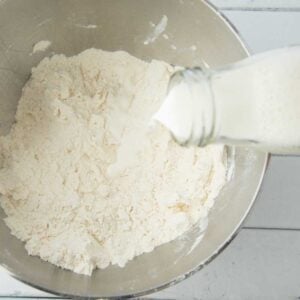


Roll out the dough: Set out the butter block for about 15 minutes. While the butter is warming up slightly, roll out the dough into a square on a lightly floured surface that’s large enough to enclose the butter block. You’ll want to place the butter at an angle so that you close it up like an envelope. You should see 4 triangles that come together in the center. You can measure to make this precise, but it’s easier to periodically place the plastic wrapped butter in the middle to see how close you are. Think of it like dry fitting a wood working project!
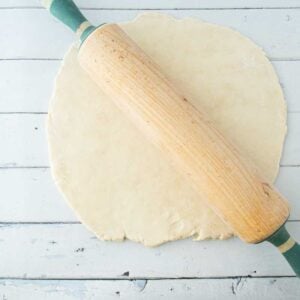

Enclose the butter: Place the butter block in the middle of the dough at an angle and bring the 4 triangle flaps together in the center. Seal up the dough edges with your hands.
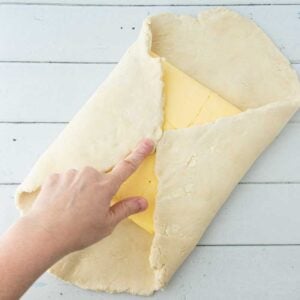
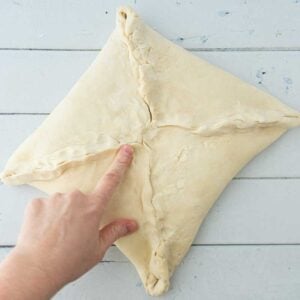
1st rolling: Press firmly and without smashing to distribute the butter in between the layers of dough. Think of denting the butter by tap tap tapping the pin along the length and sides of the dough package. Keep pressing until the dough is about 12″x18″. Fold down the top third of the dough over the middle and then the bottom third up over the middle, like a letter.


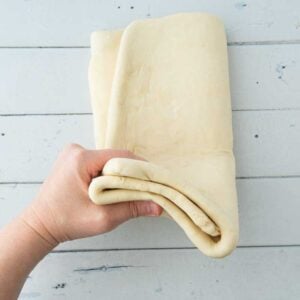
1st turn: Rotate the dough 90 degrees and roll it out again to a 12″x18″ rectangle. Note that you’ll be rolling ACROSS the folds you just made and not in the same direction. You can see how I did just that in the pictures. You should also notice that the dough will be already easier to roll (it will get easier with more turns). Fold it up again like a letter. Wrap up the folded dough and chill for 30 minutes.

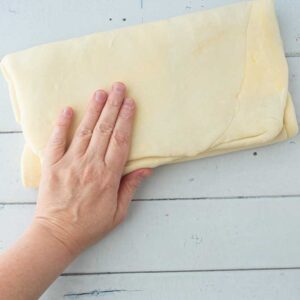
More turns: Repeat the rolling, folding and turning, chilling 15-30 minutes after every time you roll out the dough. If your kitchen is warmer, you may be able to roll the dough quickly enough to do 2 turns before chilling. If the dough starts to resist rolling, chill it. It’s not a bad idea to keep track of how many turns you’ve made on a post-it note with tally marks that you stash on your sheet tray.
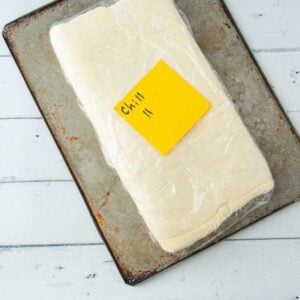
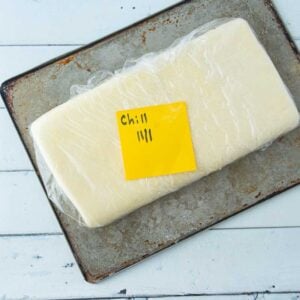
Total turns: You’ll want to roll and fold the dough 6-8 times for the best results.

How to use the dough: This recipe makes about 3 pounds of dough. Divide the dough into 3. 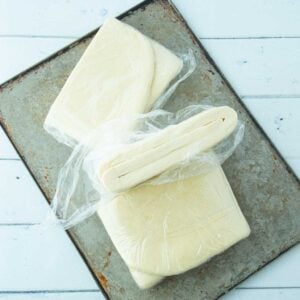 Notice all the beautiful layers of dough and butter along the cuts you made! You can either bake the dough immediately or rewrap the portions in plastic wrap and then place the plastic wrapped dough in a plastic bag for the freezer for up to 3 months. Thaw the dough in the fridge overnight before using frozen dough.
Notice all the beautiful layers of dough and butter along the cuts you made! You can either bake the dough immediately or rewrap the portions in plastic wrap and then place the plastic wrapped dough in a plastic bag for the freezer for up to 3 months. Thaw the dough in the fridge overnight before using frozen dough.
Notes
*The nutrition data was calculated assuming you can make about 20 things from each of the 3 portions of dough. Any given puff pastry recipe here may use more or less dough, but this was a rough estimate.
- Prep Time: 30 minutes
- Category: Pastry
- Method: Rolling
- Cuisine: French
Nutrition
- Serving Size: 1/60 of the dough
- Calories: 87
- Sugar: 0.2 g
- Sodium: 41.6 mg
- Fat: 6.4 g
- Carbohydrates: 6.6 g
- Protein: 1.1 g
- Cholesterol: 16.7 mg



